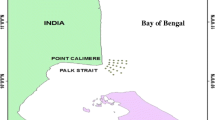Abstract
Obtaining, analyzing and understanding the seasonal dynamics of water clarity is of importance for understanding and managing lakes and sustaining their ecosystem services. This study aimed to explore the seasonal dynamics of water clarity and to analyze how water level, wind velocity and total precipitation influence this dynamics in Lake Dahuchi, China. The Secchi disk depths recorded in the field and derived from Moderate Resolution Imaging Spectroradiometer (MODIS) images together demonstrated a seasonal pattern of water clarity, which was lower in winter and spring, increased in April or May to reach the highest values in summer, upon which it gradually declined from September onward. Piecewise linear regression analysis between water clarity and water level showed that water level could explain 70% of the variation of the logarithm of Secchi disk depth. The water clarity of Lake Dahuchi was primarily controlled by suspended sediment, while the seasonal variation of water level induced different sediment resuspension, thus we concluded that the water clarity seasonal dynamics of Lake Dahuchi was mainly regulated by seasonal variation of water level.
Similar content being viewed by others
References
Brezonik PL, Kloiber SM, Olmanson LG, Bauer ME (2002) Satellite and GIS tools to assess lake quality. Technical Report 14, Water Resources Center, University of Minnesota
Chen Z, Muller-Karger FE, Hu C (2007) Remote sensing of water clarity in Tampa Bay. Remote Sens Environ 109(2):249–259. doi:10.1016/j.rse.2007.01.002
Choubey VK (1998) Laboratory experiment, field and remotely sensed data analysis for the assessment of suspended solids concentration and Secchi depth of the reservoir surface water. Int J Remote Sens 19(17):3349–3360. doi:10.1080/014311698214037
Cozar A, Galvez JA, Hull V, Garcia CM, Loiselle SA (2005) Sediment resuspension by wind in a shallow lake of Esteros del Ibera (Argentina): a model based on turbidimetry. Ecol Model 186(1):63–76. doi:10.1016/j.ecolmodel.2005.01.020
Duane Nellis M, Harrington J, John A, Wu J (1998) Remote sensing of temporal and spatial variations in pool size, suspended sediment, turbidity, and Secchi depth in Tuttle Creek Reservoir, Kansas: 1993. Geomorphology 21(3–4):281–293. doi:10.1016/S0169-555X(97)00067-6
Giardino C, Pepe M, Brivio PA, Ghezzi P, Zilioli E (2001) Detecting chlorophyll, Secchi disk depth and surface temperature in a sub-alpine lake using Landsat imagery. Sci Total Environ 268(1–3):19–29. doi:10.1016/S0048-9697(00)00692-6
Hakanson L, Boulion VV (2003) A model to predict how individual factors influence Secchi depth variations among and within lakes. Int Rev Hydrobiol 88(2):212–232. doi:10.1002/iroh.200390016
Harma P et al (2001) Detection of water quality using simulated satellite data and semi-empirical algorithms in Finland. Sci Total Environ 268(1–3):107–121. doi:10.1016/S0048-9697(00)00688-4
Hellweger FL, Schlosser P, Lall U, Weissel JK (2004) Use of satellite imagery for water quality studies in New York Harbor. Estuar Coast Shelf Sci 61(3):437–448. doi:10.1016/j.ecss.2004.06.019
Jin X, Liu H, Tu Q (1990) Eutrophication of Lakes in China. Chinese Environment Science Press, Beijing
Kloiber SM, Brezonik PL, Bauer ME (2002a) Application of Landsat imagery to regional-scale assessments of lake clarity. Water Res 36(17):4330–4340. doi:10.1016/S0043-1354(02)00146-X
Kloiber SM, Brezonik PL, Olmanson LG, Bauer ME (2002b) A procedure for regional lake water clarity assessment using Landsat multispectral data. Remote Sens Environ 82(1):38–47. doi:10.1016/S0034-4257(02)00022-6
Lathrop RG, Lillesand TM (1986) Use of Thematic Mapper data to assess water quality in Green Bay and central Lake Michigan. Photogramm Eng Remote Sensing 52(5):671–680
Li R, Li J (2004) Satellite remote sensing technology for lake water clarity monitoring: an overview. Environ Inform Arch 2:893–901
Li F et al (2005) Aerial survey of Siberian cranes in the Poyang Lake Basin (in Chinese). In: Wang Q, Li F (eds) Crane research in China. Crane and Waterbird Specialists Group of Chinese Ornithological Society, International Crane Foundation, Yunnan Educational Publishing House, Kunming, pp 58–65
Lillesand TM (2004) Combining satellite remote sensing and volunteer Secchi disk measurement for lake transparency monitoring. http://www.nwqmc.org/NWQMC-Proceedings/Papers-Alphabetical%20by%20First%20Name/Thomas%20Lillesand-Satellite.pdf. Accessed 8 June 2006
Lillesand TM, Chipman JW (2001) Satellite-assisted lake water quality: using satellite data to observe regional trends in lake transparency. GIM Int 15(11):26–29
Liu Y, Islam A, Gao J (2003) Quantification of shallow water quality parameters by means of remote sensing. Prog Phys Geogr 27(1):24–43. doi:10.1191/0309133303pp357ra
Preisendorfer RW (1986) Secchi disk science: visual optics of natural waters. Limnol Oceanogr 31(5):909–926
Sawaya KE, Olmanson LG, Heinert NJ, Brezonik PL, Bauer ME (2003) Extending satellite remote sensing to local scales: land and water resource monitoring using high-resolution imagery. Remote Sens Environ 88(1–2):144–156. doi:10.1016/j.rse.2003.04.006
Scheffer M (1998) Ecology of shallow lakes. Chapman and Hall, London, pp. 357
Shaw B, Mechenich C, Klessig L (2004) Understanding lake data (G3582). University of Wisconsin-Stevens Point, Stevens Point
Swift TJ et al (2006) Water clarity modeling in Lake Tahoe: linking suspended matter characteristics to Secchi depth. Aquat Sci 68(1):1–15
Wu Y, Ji W (2002) Study on Jiangxi Poyang Lake national nature reserve. Forest Publishing House, Beijing, pp. 231
Wu G, De Leeuw J, Skidmore AK, Prins HHT, Liu Y (2007) Concurrent monitoring of vessels and water turbidity enhances the strength of evidence in remotely sensed dredging impact assessment. Water Res 41(15):3271–3280. doi:10.1016/j.watres.2007.05.018
Wu G, De Leeuw J, Skidmore AK, Prins HHT, Liu Y (2008) Comparison of MODIS and Landsat TM5 images for mapping tempo-spatial dynamics of Secchi disk depths in Poyang Lake national nature reserve, China. Int J Remote Sens 29(8):2183–2198. doi:10.1080/01431160701422254
Author information
Authors and Affiliations
Corresponding author
Rights and permissions
About this article
Cite this article
Wu, G., de Leeuw, J. & Liu, Y. Understanding Seasonal Water Clarity Dynamics of Lake Dahuchi from In Situ and Remote Sensing Data. Water Resour Manage 23, 1849–1861 (2009). https://doi.org/10.1007/s11269-008-9356-3
Received:
Accepted:
Published:
Issue Date:
DOI: https://doi.org/10.1007/s11269-008-9356-3




